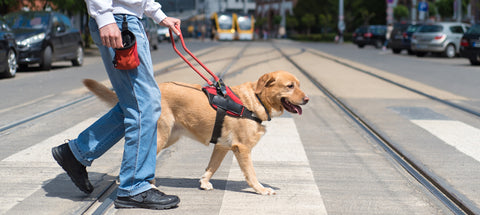Lower urinary tract infections (UTIs) are bacterial infections caused by bad bacteria making their way into the urinary tract. The bacteria commonly come from your dog’s skin or digestive tract. They bypass the urinary tract’s natural barriers and grow, causing the infection.
Our dogs can’t tell us when they’re feeling under the weather, so here are some key signs to look out for, how to treat it, and how to avoid them in the future…
Is your dog prone to UTIs?
Sadly, some dogs are more likely to develop a UTI. Senior dogs are more likely to have issues that can trigger UTIs. For example, older dogs may have loss of muscle tone, Cushing’s disease, diabetes, or kidney stones that irritate the bladder. Female dogs are also prone to these infections because they have a shorter urethra (the tube from the bladder to outside the body).

What are the signs?
While every dog is different, and some may not even show symptoms, these signs could indicate a UTI in your older canine pal.
- Drinking more
- Cloudy or bloody urine
- Licking themselves
- More frequent urination or urinating small volumes
- Fever
- Straining or whimpering while urinating
- Lethargy
- More accidents and lack of bladder control (e.g. in the house)
If your dog starts to show any of these symptoms, we recommend you take them to a veterinarian immediately. If left untreated, a UTI can develop into a more serious infection in the bladder and kidneys. Your vet may also want to investigate underlying causes of the UTI.
How to treat a UTI
When you take your dog to the vet for a UTI, they will probably recommend urinalysis to test for bacteria that confirms an infection. It is helpful if you can take a fresh urine sample in a clean pot or jar when you visit the vet.
Once they confirm there’s an infection, they may prescribe a course of antibiotics. You must make sure they take the full course of antibiotics, even if your dog seems better, to ensure all the infection is gone and won’t come back.
Getting your pup to take a pill can be tricky – try hiding it in their favorite treat (like cheese or bacon!).
You should also make sure they’re drinking plenty of water (possibly more than usual) by having lots of bowls around the house and encouraging them to drink more. This will help to keep fluid flowing through the urinary tract. Lots of rest is also key to their recovery, so short and slow walks are the way to go.
Your vet may ask you to come back for another appointment after your dog finishes their antibiotics for a second urinalysis to make sure the infection is gone.

How can you help your dog avoid a UTI?
There are no sure-fire ways to prevent UTIs in your senior dog as there are many different causes of infection. However, there are some things you can do to maintain a healthy bladder and urinary tract to avoid an infection. You can:
• Make sure they always have fresh, clean water
• Let your dog out frequently or install a doggy door!
• Check regularly to make sure your dog’s undercarriage and rear end is clean, especially around the urinary opening.
• Keep an eye out for the symptoms – the earlier you catch it the better!
If your dog is showing any signs of a urinary tract infection, it’s better to take them to the vet as soon as possible. For more information on supporting your dog’s health, check out our other Health Guides here.










